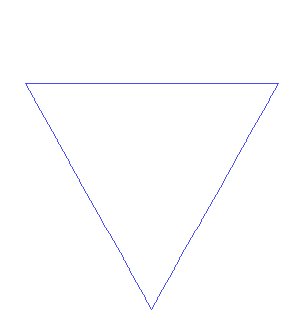Koch Snowflake
This fractal is called the Koch Snowflake. Starting with an equilateral triangle, the snowflake is formed by splitting each edge into thirds and then, for each edge drawing another triangle with the centre third of the line as its base. This is repeated infinitely. |
| By António Miguel de Campos via Wikipedia |
Calculation of Area of Koch Snowflake
At iteration 1, there are 3 edges of length s.At iteration 2, there are 4 * 3 edges since each edge is replaced by 4 edges of length 1/3 s.
At iteration 3, there are 4*(4*3) = 42 * 3 edges since each of the 4 * 3 edges is replaces by 4 edges of length 1/3 * (1/3 s) = 1/32 s.
...
At iteration n, there are 4n-1 * 3 edges of length 1/3n-1 s.
If the area of the original triangle is A, then the area of one of the additional triangles is (1/3)2 times the area of the original triangle because the length of its base is a third of the size of original. There are 3 such triangles so the total area after one iteration is
A +3(1/3)2A = A(1 + 1/3) = 4/3 A.
At iteration n, there will be one new triangle for each edge in the previous iteration, iteration n-1 giving 4n-2*3 triangles. The area of these triangles will each be (1/3n-1)2A = (1/32)n-1A = (1/9)n-1A = 1/9n-1A where A is the area of the original triangle. This gives an increase in area from iteration n-1 to iteration n of
4n-2*3 * 1/9n-1A = 3 * 4n-2/9n-1A
So, after n iterations, the total area is
4/3 A + 3*4/92A + 3*42/93 +...+ 3*4n-2/9n-1.
Apart from the first term, 4/3 A, this is a geometric progression, with initial term a=3*4/92A and common ratio r=4/9. As n tends to infinite, we have the sum of an infinite geometric progression with 0<r<1. The sum of this is
a/(1-r) = 3*4/92A / (1 - 4/9) = 3*4/92A*9/5 = 4/15 A,
and hence the total area of the Koch snowflake is
4/3 A + 4/15 A = 24/15 A = 8/5 A.
Hence, the area is 1.4 times the area of the original triangle.
Fractal Dimension
The fractal dimension of the Koch Snowflake can be thought of as too big to be 1 dimensional because every piece of it is made up of lots of smaller pieces joined at angles which means it is not like a line. It's also too small to be two-dimensional as it doesn't cover a plane.To convert an increase in the length by a fixed factor of the sides of an object in Euclean space (everyday space) to the corresponding increase in area, we have to square the factor. For instance, if we triple the length of the sides of a rectangle we have to multiply the area of the rectangle by 32. If we increase the length of the sides of a three dimensional object, he have to cube the factor we increased the length by. In other words, we can consider dimension as the power we have to use to convert.
Another way of looking at it is to look at a decrease in length. Suppose we decrease a length by a factor of 1/f. How many copies of the new object will it take to cover the new object? For example, if we cut the sides of a cube in half, then we can fit 23=8 smaller cubes inside the original cube.
Suppose we decrease the length of the side by a factor 1/f. How many copies F of the new object will we need to fill the old object?
in 2-dimensions is F=f2,
in 3-dimensions is F=f3, and
in D-dimensions is F=fD.
To extract D from this, we use logs.
log F= log (fD)
log F = D log f
D = log F/log f
For the Koch Snowflake, at each iteration, 1 line is replaced by 4 lines, each of length 1/3 the original. Hence F=4 and f=3, and so its fractal dimension is log 4/log 3 which is about 1.26.
Sources
Wikipedia: Koch SnowflakeWikipedia: Fractal dimension
No comments:
Post a Comment